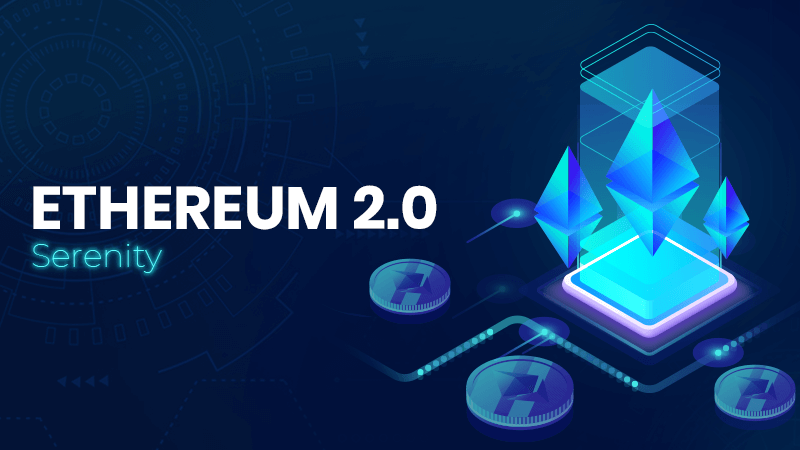Ethereum, the decentralized blockchain that features smart contracts, will be getting a series of upgrades that will see improved scalability, security, and sustainability. This massive upgrade will create new opportunities for investors. Apart from allowing Ethereum users to earn passively from staking, smart investors can take advantage of price changes during the launch of Ethereum 2.0 and multiply their investments.
In this article, we will look at what is Ethereum 2.0, what investment opportunities it creates, and how you can be part of this development.
What is Etherum 2.0 All About?
Also known as Eth2, Ethereum 2.0 is fundamentally a shift from the current proof-of-work (PoW) consensus mechanism to a proof-of-stake (PoS) model. In the PoW model, the generation of new blocks relies on the computing power of each node on the network that is taking part in transaction validation. On the other hand, PoS relies on virtual miners (also called validators) and Ether deposits to achieve consensus.
Besides changing the consensus mechanism, Eth2 also introduces shard chains – a mechanism that ‘splits’ the Ethereum blockchain and shares the processing task among different nodes. This approach increases the network’s processing capability by allowing concurrent processing of transactions – a shift from the traditional sequential processing.
While the upgrade is squarely technical, its economic and financial implications will be far-reaching.
How Will Eth 2.0 Affect Prices?
Whenever a major event happens on certain crypto, its prices are bound to change due to increased speculation. In the wake of the anticipated Eth2 launch, upward price movements were observed. The launch was set to happen on 1st December, and a week to this launch, ETH prices had gone as high as $600. While this rally might have been due to other factors, such as the general positive sentiment on cryptocurrencies, the surge observed just a week before the event can’t be coincidental.
Speculation aside, Eth2 is bringing improved transaction speeds and lower costs – factors likely to increase demand for the crypto. Already, exchanges are reporting declined sell pressure, which indicates that investors are not eager to sell ETH at the moment. The speed and transaction cost improvements will also automatically cascade to tokens that run on the Ethereum blockchain. This will trigger even more demand for the crypto and, thus, better prices.
Staking in Eth 2.0
The introduction of staking in Eth2 creates a new opportunity for investors to earn by validating transactions, and this is the latest investment opportunity we would like to discuss.
Simply put, staking in Eth2 implies depositing 32 ETH to activate validator software – the tool you will be using to process transactions. As a validator, you will have the power (and duty) to process transactions and add new blocks to the blockchain, and earn rewards while at it.
Rewards are given to validators for pushing transaction batches into new blocks and validating other validators’ work. While there are bountiful rewards in staking, you might lose ETH if you are unavailable to perform validations or if you use your stake against Eth2 validation specifications.
How to Stake in Eth 2.0
Staking involves sending 32 ETH to the following address:
0x00000000219ab540356cbb839cbe05303d7705fa
However, you will need to use the launchpad dedicated for this purpose. The address above is for verification purposes only. The process involves several distinct steps, summarized as follows:
- Review Eth2 staking agreement/ terms and conditions
- Sign up on the launchpad. This will involve depositing the 32 ETH.
- Agree that it is your responsibility to keep your validator online.
- Agree that you are liable to slashing (incurring a large penalty) if you act against validation specifications.
- Agree that you understand that your mnemonic (or seed) is the only way to access your funds and that you will keep it safe.
- Agree to safeguard your key stores, which will hold your keys, and provide the public keys to the launchpad site to activate your validator.
- Agree that you cannot transfer your staked ETH until Phase 1 and that you cannot withdraw until Phase 2.
- Agree that once you exit, you cannot rejoin as staking is a long-term commitment. (The completion of each phase depends on reaching a certain amount of staked ETH. Thus, withdrawals will keep extending timelines for this smart contract).
- Accept early adoption risks, i.e., software and design flaws that may result in the loss of your ETH.
- Agree that you are technically capable of configuring a validator.
- Select an Eth1 client that will run parallel to your Eth2 client. This is necessary to process deposit transactions coming from the Eth1 chain.
- Select an Eth2 client and set up a node. You can choose between Prysm, Nimbus, Lighthouse, and Teku. Nimbus is one of the most versatile as it can run even on older smartphones.
- Select the number of validators you would like to run and the operating system you will use. Remember, to operate each validator, you will need 64 ETH.
- Upload the validator which you downloaded/ built from the previous step.
- Finally, connect your wallet.
While staking in Eth2 is quite technical, especially for the average user, a comprehensive step-by-step guide is provided on the Ethereum launchpad website. It is also worth acknowledging the thoroughness with which the documentation was put together by the Eth2 team to guide potential validators. If you use this guide, you are unlikely to get stuck simply due to technical difficulty.
Is Eth 2.0 Staking a Good Idea?
Staking in Eth2 is a double-edged sword – it comes with both benefits and risks. When you commit your ETH to the staking contract, you are almost guaranteed returns just from staking. However, returns are highly variable. In fact, it is impossible to tell how much you can earn by staking a fixed amount of ETH until you actually receive the reward. Even so, if you stake and consistently participate in validation, you will get rewarded.
Secondly, staking means locking your ETH to the network for some time, without the possibility of withdrawing it at least until Phase 1.5. This is akin to depositing with a fixed account, whose interest can be compared to the growth of ETH in the near future.
While staking is a good way to earn from Eth2, you might want to consider the following risks:
- Staking is a one-way deposit. ETH you send to the contract address cannot be withdrawn until an unknown future date (this is until Phase 1.5 of the upgrade is reached).
- Profits you earn from staking also remain staked until this unknown future date.
- Validation is a responsibility that all stakers must undertake. By being offline, you will lose as much as you would have earned if you were available for validation.
Final Thoughts
The coming of Eth2 brings with it exciting investment opportunities. Other than the traditional trading and HODLing, Eth2 allows you to commit some funds to the network and join other validators and earn exclusive rewards from it. Risks, including early-adoption software bugs and slashing due to being offline, exist. However, all considered, staking is a worthy venture that ETH investors should consider.




